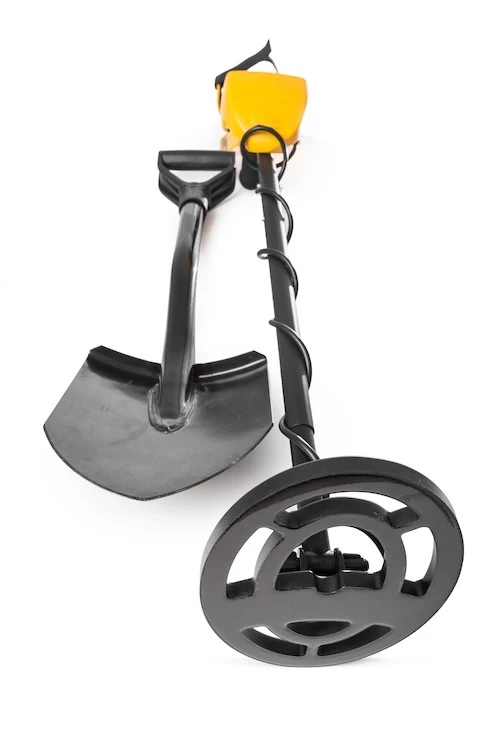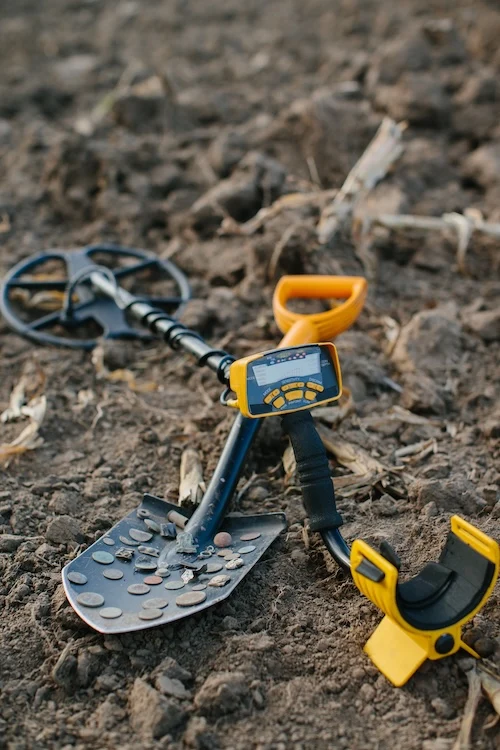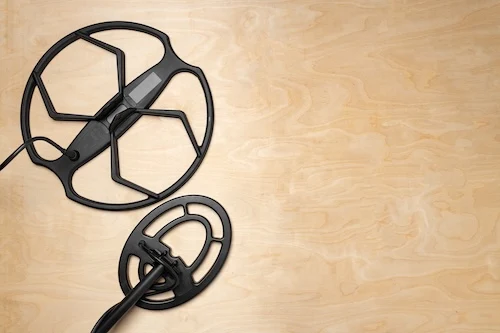How A Metal Detector Works Explained

Written by Piotr Lesniewski
Detectorist • Scotland
As an Amazon Associate we earn commission from qualifying purchases. Read our full Affiliate Disclosure.
Understanding the physics behind these devices reveals both their capabilities and limitations.
The fascinating interplay of magnetic fields and electronic signals transforms a simple coil arrangement into a powerful detection tool.
Key Takeaways
- Metal detectors create a magnetic field that interacts with metallic objects, generating eddy currents in these objects.
- When the magnetic field contacts metal, the metal produces a secondary magnetic field that the detector can sense.
- VLF detectors use separate transmitter and receiver coils, while PI detectors use a single coil for both functions.
- The device processes detected signals by filtering interference and comparing signals to known metal signatures.
- Detectors distinguish between metal types based on conductivity, with highly conductive metals producing stronger signals.
Generating a Primary Magnetic Field
The transmitter coil initiates the metal detection process by converting electricity into a magnetic field. As electric current flows through the coil, it generates a primary electromagnetic field that radiates outward from the search head and penetrates the ground or scanning area.
This field is dynamic rather than static, functioning according to the detector’s operational design. Very Low Frequency (VLF) detectors utilize an alternating current to create a continuously changing electromagnetic field, while Pulse Induction (PI) detectors emit rapid pulses of electromagnetic energy in discrete bursts.
The primary field serves as the detector’s probing mechanism, extending the device’s sensing capability beyond its physical boundaries and establishing the foundation for metal object identification through electromagnetic interaction.

Inducing Eddy Currents
Metallic objects within the detector’s search field become energized when the primary magnetic field contacts them. This interaction creates tiny circular electrical flows called eddy currents that circulate within the metal’s structure.
The strength of these induced currents varies significantly based on the metal’s conductivity properties. Highly conductive metals such as silver and copper generate particularly strong eddy currents due to their efficient electrical transmission characteristics.
In contrast, metals with lower conductivity produce weaker eddy current signatures. This variation in response forms the fundamental basis for a metal detector’s ability to not only detect the presence of metal objects but also potentially identify their composition.
The eddy currents represent a critical intermediate stage in the detection process, transforming the detector’s emitted energy into a measurable response within the target object.

Creating a Secondary Magnetic Field
Once eddy currents establish themselves within a metal object, they initiate the next phase of the detection process.
These currents, circulating within the conductive material, generate their own secondary magnetic field in response to the primary field from the detector.
This secondary magnetic field radiates outward from the metallic object and possesses specific characteristics that vary depending on several factors.
The type of metal, its size, shape, and orientation all influence the strength and phase of this responsive field.
For instance, ferrous metals produce different field signatures than non-ferrous materials.
The secondary field interacts with the detector’s circuitry, creating a detectable disturbance in the original field pattern.
This interaction forms the basis for the detector’s ability to not only locate metal objects but also potentially identify their composition and approximate size.
Detection by the Receiver Coil
At the heart of a metal detector’s functionality lies the receiver coil, which functions as the device’s primary sensory organ for detecting metallic objects. This crucial component is strategically positioned to capture the secondary magnetic field generated when the detector’s transmitted field interacts with metal objects.
In Very Low Frequency (VLF) detectors, the receiver coil is separate from the transmitter coil, carefully calibrated to maximize detection sensitivity while minimizing interference. Its precise positioning allows it to pick up even subtle magnetic field changes created by buried metal objects.
Pulse Induction (PI) detectors employ a different approach, utilizing a single coil that performs both transmission and reception functions. This dual-purpose coil first sends out the magnetic pulse and then switches to receiving mode to detect any returning signals from metallic objects in the vicinity.

Signal Processing and Alert
After the receiver coil detects magnetic field changes, the real analytical work begins in the metal detector’s processing system. The electrical signal generated by the receiver coil travels to the control box, which houses sophisticated electronics designed to analyze and interpret this information.
Within the control box, specialized circuitry filters out interference from non-metallic sources, particularly mineralized ground—a function often enhanced by “ground balancing” features.
The processor then examines the filtered signal, comparing it against known metallic signatures. When a match occurs, the system triggers an alert, typically through audible tones or visual displays on the device’s interface.
Modern detectors offer increasingly refined feedback, with many capable of identifying probable metal types and estimating the object’s depth beneath the surface, providing treasure hunters with valuable targeting information.

Key Components of a Typical Metal Detector
A standard metal detector consists of several key components that work together to locate metal objects.
The control box houses the electronic components, including the processor, controls, speaker, and power supply, while the search coil contains the transmitter and receiver coils that generate and detect electromagnetic fields.
The adjustable shaft connects these main elements, with an optional stabilizer sometimes added to provide additional support during extended use on uneven terrain.
Control Box
The control box serves as the central command center of a metal detector, housing all the critical electronics that power its operation. Often referred to as the “brain” of the device, it contains the batteries that provide necessary power and the sophisticated circuitry responsible for generating transmit signals and processing received signals.
The control box also incorporates user-adjustable settings that enhance detection capabilities. These include sensitivity controls that adjust the depth and range of detection, discrimination features that allow users to ignore specific types of metals (preventing unwanted alerts from items like aluminum cans or bottle caps), and ground balance settings that help filter out mineralization in soil that might otherwise trigger false signals.
This component ultimately determines the detector’s effectiveness and adaptability to various search conditions.
Search Coil
While the control box serves as the metal detector’s brain, the search coil functions as its sensory organ, actively interacting with the environment to discover buried objects. This component sweeps across the ground surface during operation, housing the critical transmitter and receiver coils that generate and detect electromagnetic fields.
The design of the search coil significantly impacts the detector’s performance characteristics. Various sizes and shapes are available, each offering different advantages.
Larger coils generally provide greater depth penetration but may sacrifice sensitivity to smaller targets. Conversely, smaller coils excel at pinpointing tiny objects with precision but have reduced detection depth.
Specialized shapes like elliptical or DD configurations offer unique detection patterns suitable for specific hunting environments. Manufacturers optimize coil designs to balance depth capability with target discrimination across different detecting conditions.
Shaft
Connecting the intelligent control box to the sensitive search coil, the shaft forms the ergonomic backbone of any metal detector system. This critical component not only provides the physical structure that unites the metal detector’s primary elements but also houses the internal wiring that enables communication between these components.
Most modern metal detectors feature adjustable shafts that can be lengthened or shortened to accommodate users of varying heights. This adaptability ensures proper scanning posture, reducing back strain during extended treasure hunting sessions.
Some premium models offer additional ergonomic features such as cushioned grips and angled designs that enhance comfort.
The shaft’s construction material contributes significantly to the detector’s overall weight and durability. Manufacturers typically use lightweight yet robust materials like aluminum or carbon fiber to balance maneuverability with structural integrity.
Stabilizer (optional)
Considered a valuable enhancement by serious detectorists, the stabilizer represents an optional yet significant addition to metal detector design. This component typically attaches to the shaft in the form of an armrest or supporting structure that helps distribute the weight of the detector more evenly across the user’s arm.
The primary function of a stabilizer is to increase comfort during extended detecting sessions while simultaneously improving control and precision during sweeping motions. By reducing fatigue and minimizing arm strain, the stabilizer allows users to maintain proper technique for longer periods.
This results in more thorough scanning and potentially greater success in finding buried objects. Though not essential for basic operation, many experienced users consider the stabilizer indispensable for serious fieldwork, particularly in challenging terrain or during all-day detecting expeditions.

Common Types of Metal Detector Technologies
Metal detectors utilize several distinct technologies to locate buried objects, with Very Low Frequency (VLF) and Pulse Induction (PI) systems being the most prevalent.
VLF detectors employ two coils—a transmitter and receiver—to create and detect electromagnetic fields disrupted by metallic objects.
PI detectors, conversely, send powerful, short bursts of current into the ground and measure the decay time of the returning pulse, making them particularly effective in highly mineralized soils or saltwater environments.
Very Low Frequency (VLF) Detectors
Very Low Frequency (VLF) detectors dominate the consumer metal detection market due to their balanced performance and accessibility. These devices operate using a dual-coil system: a transmitter coil emits continuous sine waves in the kilohertz range, while a separate receiver coil captures the response.
When these low-frequency waves encounter metal objects, they induce eddy currents, generating a secondary magnetic field that differs in phase from the original transmission. The detector’s electronics analyze these phase shifts and amplitude changes to determine both the presence and type of metal. This enables VLF detectors to effectively discriminate between different metals such as iron, gold, and silver.
While VLF technology offers affordability and good discrimination capabilities, its primary limitation is increased susceptibility to interference from mineralized soil conditions.
Pulse Induction (PI) Detectors
Pulse Induction (PI) detectors represent a specialized category of metal detection technology optimized for challenging environments. Unlike VLF systems, PI detectors employ a single coil that functions as both transmitter and receiver, sending powerful, brief current pulses that generate magnetic fields.
When each pulse ends, the magnetic field collapses rapidly, creating a reflected electrical spike in the coil. Metal objects prolong this spike’s decay time, as eddy currents within the metal generate their own magnetic field. The detector measures this decay duration to identify metal presence.
PI detectors excel in difficult conditions, offering superior depth capabilities for larger objects and performing exceptionally well in highly mineralized soil and saltwater environments.
Their effectiveness makes them ideal for beach hunting and gold prospecting. However, they typically offer less discrimination between metal types than VLF detectors and come at a higher price point.
Conclusion
Metal detectors operate on simple yet sophisticated electromagnetic principles. By generating magnetic fields that interact with metallic objects, these devices create a reliable detection system. The interplay between transmitter and receiver coils, coupled with advanced signal processing, allows for accurate identification of buried metals. This technology continues to evolve, offering increasingly precise detection capabilities for various applications from security to archaeology.
Author Profile

Piotr Lesniewski
"Digging up the past, one signal at a time."
Polish-born, Scotland-based, and obsessed with the beep. My passion began decades ago, exploring fields with my Dziadek (grandfather). Now, with over 10 years of digging under my belt, I'm here to share everything I've learned—unfiltered and unbiased—to help you unearth your own piece of history. No sales pitches, just real field experience.